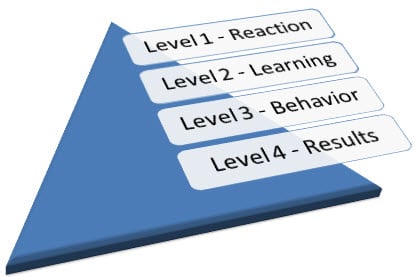How Can I Measure E-Learning Effectiveness?

The famous management guru William Edwards Deming once said that “what you cannot measure you cannot manage it”. This principle even applies to the training Managers when it comes to measuring effectiveness of their training interventions.
It is important for training managers to know how to prove that training initiatives are indeed value-added projects. This can be done based on an awareness of the advantages of e-Learning such as time reduction, scalability, consistency, improved productivity, cost reduction, profitability impact and other factors. They can thereby gain the support of the top management for future training interventions and thus guarantee a successful e-Learning strategy throughout the corporation.
Many years ago Donald Kirkpatrick developed a classical model for all those who are into corporate training business which makes assessing easy for both ILT (Instructor Led Training) and eLearning.
This model comprises four progressive levels:
Level I: How do learners feel?
In this level, training is evaluated by students at the end of program. The objective behind measuring learners feel on the training is to find valuable information. Some organizations roll out online survey forms to evaluate the learners feel on the Web-based e-Learning.
Level II: Learning results
This level’s emphasis is on measuring learning results: whether students absorbed skills, knowledge, and attitudes as stated in the learning objectives. To achieve this, Kirkpatrick recommends in his book to conduct a pretest and a posttest which help to compare results and observe the first training effect delivered via ILT or eLearning.

Level III: Workplace behavior
When HR Manager or a Training Manager chooses an e-Learning program to address trainings, one of the key questions to ask is whether this kind of training helps the trainee to transfer the knowledge and skills acquired, to his/her daily work or job. In this regard the Kirkpatrick model seeks to find out if behavior of the student has changed as a result of the learning experience.
Kirkpatrick recommends conducting evaluation a few months later to check if trainees are applying acquired knowledge in their work.
Level IV: Business results
This is the last level in the Kirkpatrick model which aims to measure the business results that contribute to the “bottom line” of the company. It includes the fact which most people would agree with, that any outcome which is “good for the business.” is a criterion in the ‘bottom line’ factors. The outcomes could be either changes in financial outcomes (such as positive ROI or increased profits) or changes in variables that should have a relatively direct effect on financial outcomes at some point in the future.
It is important for corporate training managers to evaluate the effectiveness of eLearning training programs because it makes possible program benefit, scope, and improvement analysis. Companies praise online training as a convenient, cost-effective, and effective way to deliver corporate education.
Thank you for your time spent in reading my blog. Please do share how you evaluate online training programs which you initiated in your organization.





